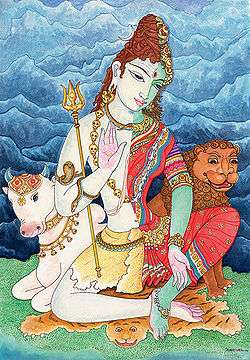Stotra
| Part of a series on |
| Hindu scriptures and texts |
|---|
 |
|
Rig vedic
Sama vedic Yajur vedic Atharva vedic |
|
Other scriptures |
| Related Hindu texts |
|
|
|
Timeline |
Stotra or Stotram (stotra) is a Sanskrit word, that means "ode, eulogy or a hymn of praise".[1][2] It is a literary genre of Indian texts designed to be melodically sung, in contrast to shastras which are composed to be recited.[1]
A stotra can be a prayer, a description, or a conversation, but always with a poetic structure. It may be a simple poem expressing praise and personal devotion to a deity for example, or poems with embedded spiritual and philosophical doctrines.[3]
Many stotra hymns praise aspects of the divine, such as Devi, Siva, or Vishnu. Relating to word "stuti", coming from the same verb, stu (to praise), and basically both mean "praise". Notable stotra are Shiva Tandava Stotram in praise of Shiva and Ram Raksha Stotra a prayer for protection to Lord Rama. Stotras are a type of popular devotional literature. Among the early texts with Stotras are by Kuresha, which combine Ramanuja's Vedantic ideas on qualified monism about Atman and Brahman (ultimate, unchanging reality), with temple practices.[3]
Stotram is also commonly used in Christian hymns, worship and prayers describing the praise and personal devotion to Jesus Christ in several South Indian Christian belief and tradition.
Etymology
Stotra comes from the root stu- which means "praise, eulogize or laud".[3] Literally, the term refers to "poems of praise".[4] The earliest trace of Stotras are Vedic, particularly in the Samaveda.[4]
Example

The following is a Peterson translation of a Stotra by the Tamil poet Appar for Ardhanarishvara, the Hindu concept of a god who incorporates both the masculine and the feminine as inseparable halves.[5]
An earring of bright new gold one ear,
a coiled conch shell sways on the other,
On one side he chants the Vedic melodies,
on the other, he gently smiles,
Matted hair adorned with sweet konrai blossoms on one half of his head,
and a woman's curls on the other, he comes.
The one the nature of his form, the other of hers,
And both are the very essence of his beauty.— Appar, Ardhanarishvara Stotra, [5]
Nama-stotra
The nama-stotra is based on chanting a litany of names for a deity. The Sahasranama, a type of nama-stotra, is a litany of a thousand names for a particular deity. Sahasranama means "1000 names"; Sahasra means 1000 and nama means names. For example, Vishnu Sahasranama means 1000 names of Vishnu.[6] Other nama-stotras may include 100 or 108 epithets of the deity. According to Hinduism, the names of God are valuable tools for devotion.
Notable stotras
- Shiva Tandava Stotram
- Dakshinamurthy Stotram
- Shiv Mahimna Stotra
- Panchakshara Stotra
- Ram Raksha Stotra
- Mahishasuramardini Stotra
- Maruti Stotra
- Agasti Lakshmi Stotra
- Dvadasha stotra
- Jainism
- Upsargahara Stotra
- Bhaktamara Stotra
See also
References
- 1 2 Monier Williams, Monier Williams' Sanskrit-English Dictionary, Oxford University Press, Article on Stotra
- ↑ Apte 1965, p. 1005.
- 1 2 3 Nancy Ann Nayar (1992). Poetry as Theology: The Śrīvaiṣṇava Stotra in the Age of Rāmānuja. Otto Harrassowitz Verlag. pp. ix–xi. ISBN 978-3447032551.
- 1 2 Nancy Ann Nayar (1992). Poetry as Theology: The Śrīvaiṣṇava Stotra in the Age of Rāmānuja. Otto Harrassowitz Verlag. pp. 15–16. ISBN 978-3447032551.
- 1 2 Ellen Goldberg (2012). Lord Who Is Half Woman, The: Ardhanarisvara in Indian and Feminist Perspective. State University of New York Press. pp. 91–96. ISBN 978-0791488850.
- ↑ Vishnu Sahasranamam on Hindupedia, the Online Hindu Encyclopedia
Bibliography
- Apte, Vaman Shivram (1965), The Practical Sanskrit Dictionary (Fourth revised and enlarged ed.), Delhi: Motilal Banarsidass Publishers, ISBN 81-208-0567-4